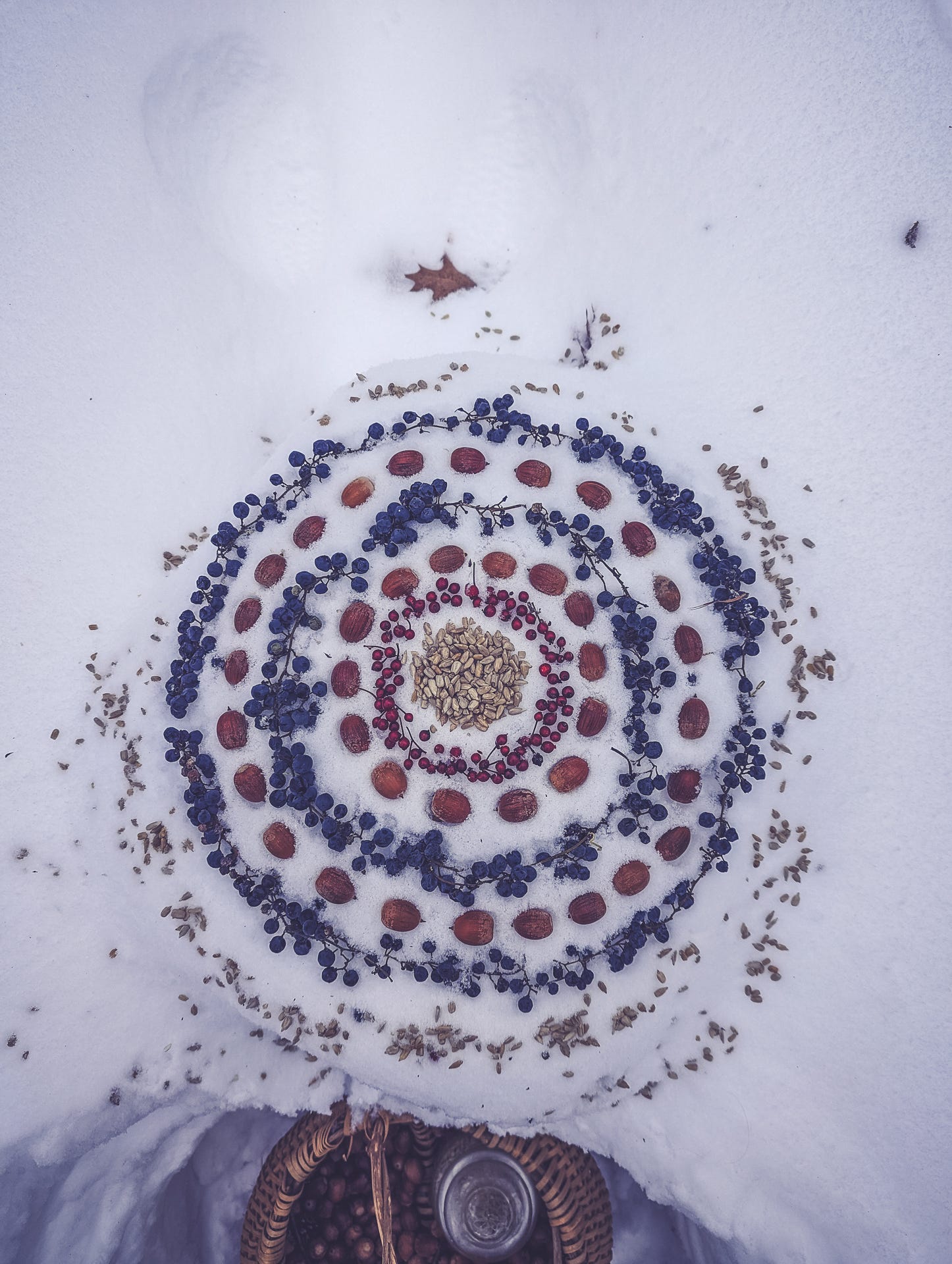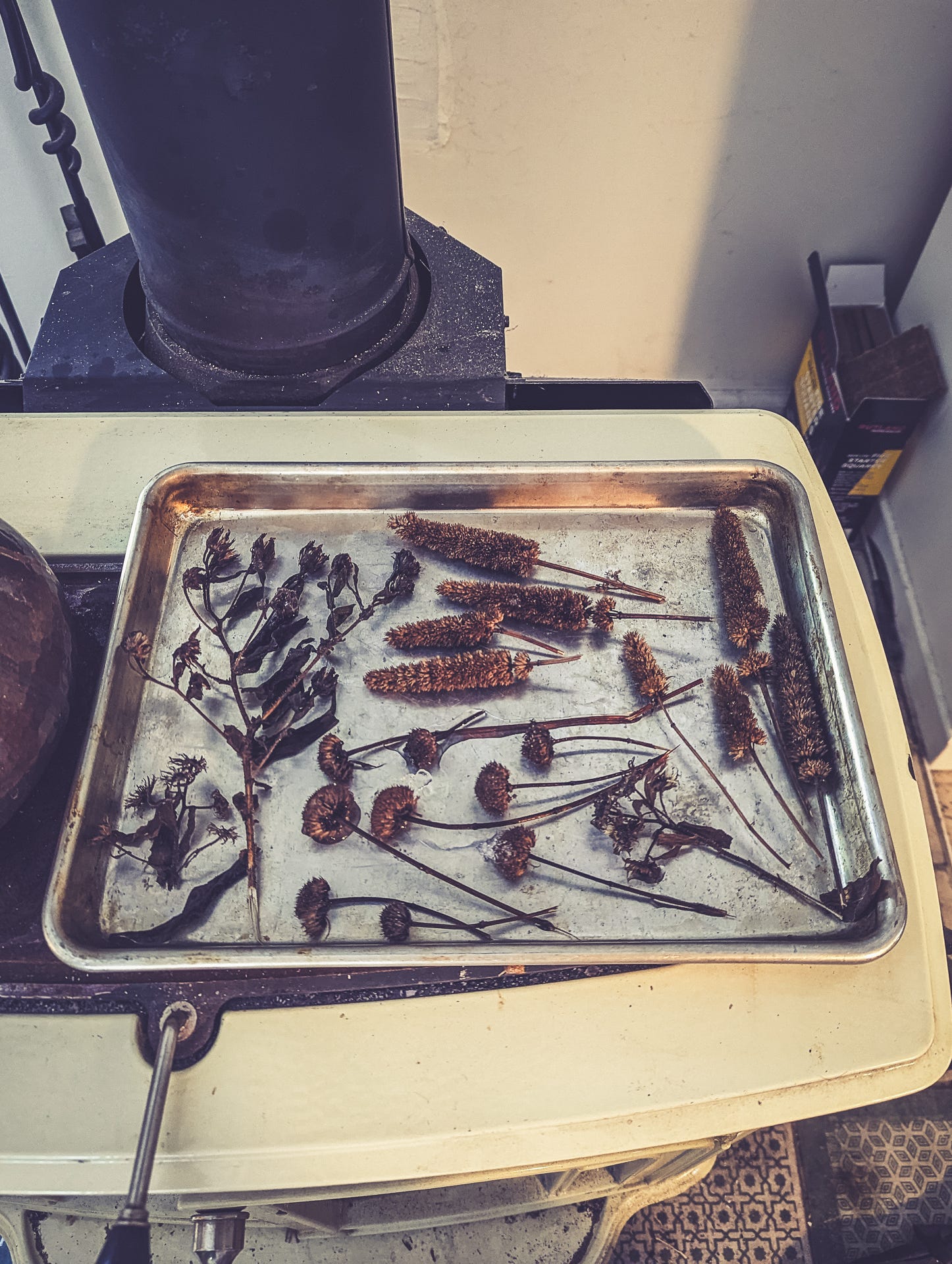Winter rides its skeletal steeds across the sky, continuing its wild hunt. Humans and animals retreat to the warmth of our hollows and hearths. Only the plants stay, welcoming winter’s cold embrace and certain death time after time. We seek self preservation, but the plants give themselves to the will of the wild effortlessly, infinitely, indefinitely. All this sacrifice so that at least one single seed may shake free and root itself deep in the soil at our feet.
To land-based cultures, the seed is the messiah. It is born with the sun, turning a seemingly inanimate grain into living food, sustaining both the body and spirit. Then it dies, releasing a cascade of new seeds to the soil so that we may live again.
The seed is divinity encapsulated in matter we can touch, hold, worship. Something tangible to base our faith on. It is a god, an ancestor, a companion, a story, the beginning and end of all things.
It is why Africans wove seeds of okra, licorice, black-eyed peas, and yams into their hair when they were forced from their land and into slavery. It’s why Polish immigrants sewed seeds of cornflower and cabbage into their clothing when fleeing Prussian occupation. This divinity is the reason the indigenous Anishinaabek people of the Great Lakes treat the harvest lands of the manoomin, the wild rice, like a shrine.
It will always break open my heart when I think about the relationship between seeds and people. In the face of incomprehensible upheaval, seeds were home. They still are. The fact that people go to such lengths to preserve these tiny talismans says everything that words cannot.
I don’t think it’s something we can really comprehend unless we collect seeds with our own hands. Because the cycle ends when the plant dies back to the ground, but the cycle continues when we take the seeds and tuck them into new soil. It’s like another missing piece of the puzzle falls into place when we winnow the seeds from the shaft, paying homage to a new generation. Another piece of an old skill coming back.
While we are told to harvest seeds in the fall, it still isn’t too late to harvest them now! You may not be able to collect as many seeds, but you always need less than you think. The seeds are not dead, just dormant.
This is how I spent my day after the storm. Rooting through the snow, collecting lifeless stalks, drying them over the wood stove, coaxing the seeds out of their little cocoons. These grains of life, buried beneath death, are truly the heart of the miracle.
Though we barely give the seed a second thought, this tiny specimen is a microcosm of swirling potential. In biodynamics, it is said that the seed is an embodiment of chaos. While this term is often given negative connotations, one definition claims “chaos” as “the formless matter supposed to have existed before the creation of the universe”.
Within the seed lies the same thing that created all things. Chaos seems scary to us because it is uncontrollable, unpredictable. These are the two things us humans fight against constantly. Yet in reality, it is completely natural. With chaos, all things are burned away until only truth remains. The face of the universe is revealed in the ashes.
For the seed, it is the combination of fire, water, earth and air that initiates these chaotic energies. As the embryo of the seed is stimulated, it begins to expand, much like the universe itself in the very beginning. Metabolic processes and respiration, which have been quieted during dormancy, increase. This formless matter bounces, swirls, collides, jumps and pushes in all directions until a mini Big Bang occurs and the first root breaks free of the shell, diving deep and with purpose into the soil.
As biodiversity continues to decrease, this small act of ensuring the children of these plants survive for another generation is something tangible we can do to make a difference. May our devotion be unconditional and intentional.
Much love,
Val
An invitation
Pay homage to the life-giving gift of the seed by leaving a little seed altar outside for the birds and animals that stay throughout winter, like the one I created above. Add little berries, acorns or other animal friendly foods if you want. If you’re in a cold area like me, it just feels good to spend some time in the cold stillness. Bundle up!
And/or collect some dead seedheads you would like to harvest seeds from for the year to come. If it is wet and snowy where you live, dry them ever so gently in a warm (but not too warm) space. I used the top of my wood stove for a short period of time just to melt the snow and wick any moisture still lingering inside the seedhead. Once dry, store in a sealed envelope until planting day.
If you want to move deeper into a seasonal land-based life, consider ordering my 2024 edition of the Lunica Planner. Because learning to live in tune with the land doesn’t come from grand gestures or life-altering shifts, but rather from daily routines, devotions and observations of the land and how we relate to it.
Lunica was created to be a gardener’s almanac and planner, complete with lunar gardening guides, record keeping, recipes, essays, and plenty of space to journal, plan and reflect.
Purchasing a planner also helps support this publication!
Thank you so much for being here! I also write a subscription-based newsletter that helps expand your plant knowledge by combining science and spirit. We go past surface level learning and dive deep into the multi-layered world of herbalism and gardening with practical recipes, case studies, tutorials, story, and folklore to bring your understanding into practice.










Magical, rooted piece. Val, thank you
Beautifully written article, Val! Such poetry as well as divinity do seeds embody. After reading each of your pieces I feel uplifted and optimistic about life, the future, and my small role in it. Thank you for sharing your insight and wisdom.